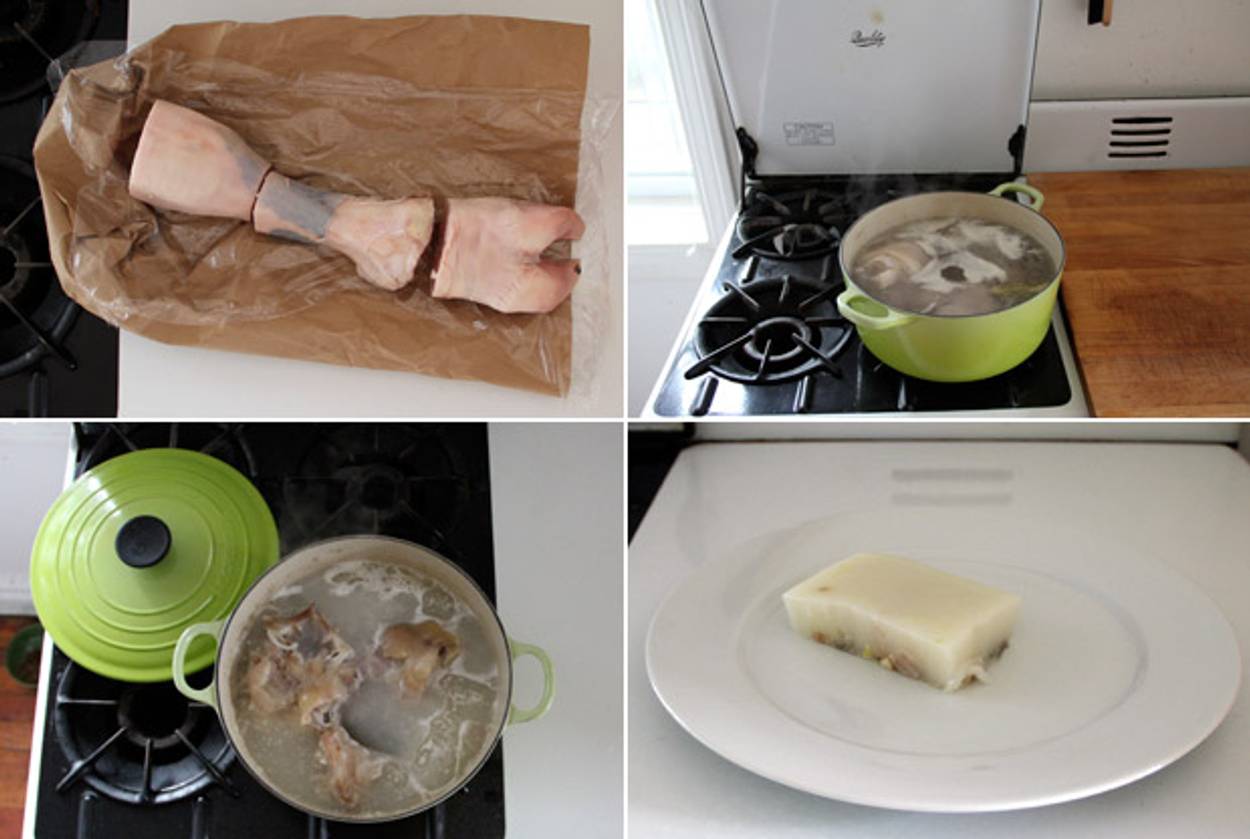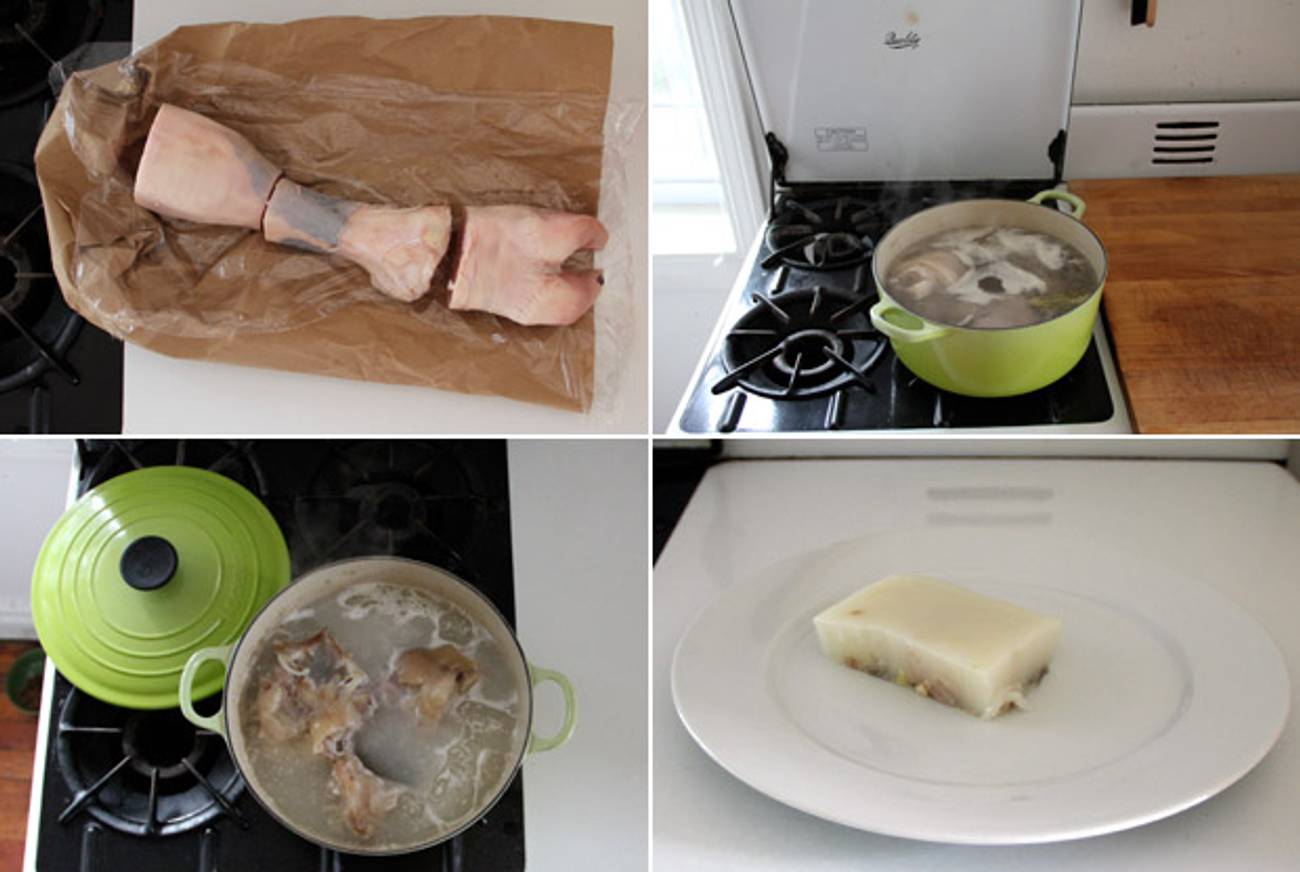A Disappearing Delicacy
As ptcha—a classic Ashkenazic dish made from jellied calves’ feet—disappears from deli menus, American Jews lose a culinary link to past generations




Ptcha, the humble dish of jellied calves’ feet, is on the verge of extinction in America.
While matzo ball soup and latkes have garnered crossover appeal as modern Jewish bistro fare, thus ensuring their survival here, this gelatinous appetizer never found a non-Jewish audience, and even its Jewish fans are disappearing, landing ptcha on the endangered list. In fact, the number of names for the dish—also known as sulz, drelies, fisnoga, or holodets—is greater than the number of menus where it still appears in New York City.
“I don’t think ptcha would be a big seller [for us],” said Kutsher’s Tribeca owner Zach Kutsher, who doesn’t sell the stuff. “It never came up in any menu conversations.”
Manhattan’s 2nd Avenue Deli does serve ptcha, but even there, the customer base is narrow—and shrinking. “We basically make it in the store for just a handful of customers who like it,” said owner Jack Lebewohl.
Ptcha is more than a dish, though: It’s a Jewish delicacy whose American history carries a story of immigrants, struggle, and resourcefulness. It’s a culinary heirloom that, unless passed on to the younger generation, will break a link to generations past.
***
Ptcha originated in the 14th century as a popular Turkish soup, writes Gil Marks in The Encyclopedia of Jewish Food. The peasant dish was “based on lamb’s feet, known as paca corbasi,” he writes, “from the Turkish paca (foot), and called soupa patsas or simply patsas by the Greeks.” As the foot soup cooled, the gelatin congealed. When this dish spread to Central and Eastern Europe, cooks opted for cow’s rather than lamb’s foot and preferred the cooled jelly over the hot soup. Marks explains: “The dish allowed cooks to transform one of the least expensive parts of the animal into an Ashkenazic delicacy.”
Though ptcha was more popular in Eastern Europe, German Jewish immigrants were the first to document ptcha in the United States, notes Bonnie Slotnick, owner of New York City’s store Bonnie Slotnick Cookbooks. “German Jewish immigrants were famously very assimilated, even when they were in Germany,” she said, thumbing through two separate halves of an 1890 edition of the Jewish-American Aunt Babette’s Cook Book. For instance, the book makes no mention of Passover and instead names Easter the ideal time to serve “metropolitan apple pudding” (ahem, haroset). She pointed to the ptcha recipe, listed in German as sulze von kalbsfuessen rather than as ptcha. Aunt Babette’s Cook Book’s treatment of sulze and Passover, Slotnick explained, holds a mirror up to a generation of Jews eager to adapt their customs to those of their former country Germany and their new homeland America.
In 1918, The International Jewish Cook Book reconnected ptcha with its Jewish heritage and included “those time-honored recipes which have been handed down the generations by Jewish housewives (for the Sabbath, Passover, etc.).” Author Florence K. Greenbaum, a Central Jewish Institute cooking teacher, includes two ptcha recipes, as well as instructions for setting the Passover table and “rules for kashering.”
Marks’ Encyclopedia notes that ptcha was “well received by most of the first generation of American Jews to be brought up on the dish” and was served at weddings. However, Lynn Jawitz of Long Island, a second-generation American who grew up eating ptcha, laments that her Galicia-born grandmother made the dish constantly. Her bubbe spent her life cooking it not out of celebration but out of utility. “They had tough, tough times during the Depression,” Jawitz recalled. “When you’re taking these bones and making stuff out of them, it just sort of shows that maybe you couldn’t afford the meat.”
Judy Bart Kancigor calls ptcha “standard shtetl fare” in her 2007 book Cooking Jewish: “My friend Marci Klein thinks good [ptcha] must be covered with a thin film of soot, as her mother always cooled it on the fire escape.”
Rose Levy Beranbaum, award-winning author of The Cake Bible, told me via email about her memories of ptcha. Although her Russian émigré grandmother served it to her uncle, who loved the dish, she wrote: “I would never have dreamed of touching it.” Still, Beranbaum includes a ptcha recipe in her 1994 book Rose’s Melting Pot and states that this meal, developed by Jews who “could not afford more expensive cuts of meat,” was also a “truly ethnic delicacy, a sort of Slavic/Jewish soul food.”
Lebewohl, who as a toddler immigrated to the United States with his family after World War II from a displaced-persons camp in Italy, recalls being raised on the savory jelly. “My mother made ptcha all the time, and I developed a taste for it for that reason,” he said, which is why he still includes it on his eatery’s menu. “It’s the type of food that you come in to eat that reminds you of home, that reminds you of what your mothers and grandmothers used to make.”
However, the demand for ptcha is slowly declining. Lebewohl said. “I’m 63 years old, and the people who normally eat it call me ‘Hey, sonny!’ ‘Hey, kid!’ That gives you an idea of the age of the people who eat it.” He remembers one elderly woman who, up until about 10 years ago, would call the restaurant every year to order a tray of ptcha for her husband’s birthday. “And then, all of a sudden, she stopped calling,” he said. As long as ptcha remains a relic of the turn of the century, the Depression, and the Lower East Side shtetls, it will pass on at the same rate as its mostly elderly fans.
So, is there any way to bolster ptcha for the younger generation? Beranbaum had one idea: “What with all the garlic and wonderful chewy morsels, perhaps the best way to get people interested is to change the name to something more appealing. It is not that dissimilar to various gelatin-based recipes that come from other European countries such as France [which has] oeuf en gelée.”
Alain Cohen, owner of Los Angeles’ Got Kosher, notes that his “old school” Tunisian dishes with calf’s foot, such as t’fina camounia, now court “a crowd of American fans [who] like to explore new dishes.” Beranbaum and Cohen suggest that, in order to preserve ptcha, restaurateurs must rebrand the dish for foodies in search of the luxurious and exotic.
After all this talk about ptcha, it’s time for me to try some—for the first time. As I sit on a midnight-blue barstool at the 2nd Avenue Deli’s counter, I slice into the bizarre, obscure appetizer that I’ve been researching for weeks. I take a bite, and as the garlicky gelatin hits my tongue, I’m surprised that it’s not the unappetizing peasant dish I was expecting. I had assumed that ptcha would be as musty as the 1890 copy of Aunt Babette’s Cook Book. Instead, it is savory and sour and satisfyingly mushy. With its neat appearance, its translucent amber hue, and its settled flecks of meat, it looks not unlike an odd gem, luminous and undiscovered.
***
Like this article? Sign up for our Daily Digest to get Tablet Magazine’s new content in your inbox each morning.
Grace Bello is a freelance writer and writing teacher based in New York.
Grace Bello is a freelance writer and writing teacher based in New York.